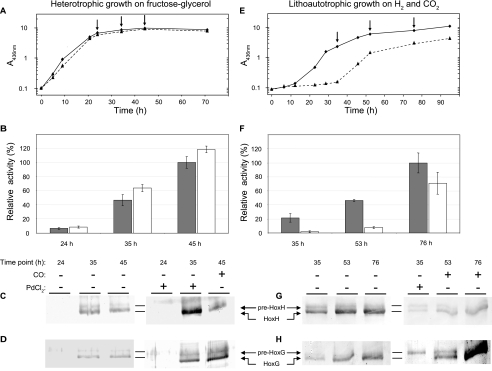FIGURE 3.
Effect of CO-limitation in R. eutropha H16. A and E, growth of cells (measured as A at 436 nm) cultivated under lithoautotrophic (H2, CO2, O2) and heterotrophic (fructose-glycerol, O2) conditions, respectively, with (dashed lines) and without (solid lines) CO limitation. CO limitation was induced at inoculation through addition of gas-permeable capsules containing PdCl2. After 35 h of cultivation, the capsules were removed, and 5000 ppmv of CO was added to the culture headspace. Samples were withdrawn at individual time points (arrows). Activity of the soluble, NAD+-reducing hydrogenase was assayed for lithoautotrophically (B) and heterotrophically cultivated (F) cells. Bars represent the activities measured in cultures with (white) and without (gray) initial CO limitation. An activity of 100% corresponds to 3.7 ± 0.4 Units/mg and 1.3 ± 0.1 Units/mg in B and F, respectively. Error bars represent the S.D. of at least three independent experiments. C, D, G, and H, corresponding immunological analysis of the large subunits, HoxH and HoxG, of the soluble and membrane-bound hydrogenase, respectively. Proteins were separated on denaturing 12% (w/v) SDS gels. The premature forms (68.8 kDa for pre-HoxG and 54.9 kDa for pre-HoxH) are slightly larger than the fully matured forms (67.1 kDa for HoxG and 52.3 kDa for HoxH).

